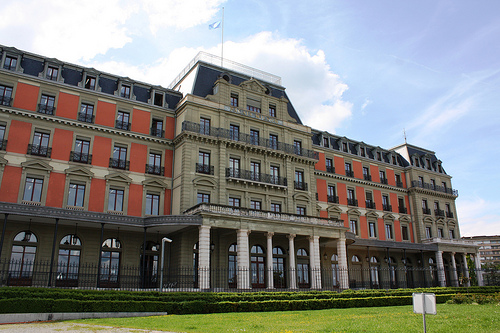
Photo: Palais Wilson, home of the Brundtland Commission for 3 years by NiklasPlutte
Last month, and one year ahead of the 2012 Earth Summit, Prof. Jacob Park asked the question “Is sustainable development still relevant?” on OurWorld 2.0, a UN University blog.
We are at 391 ppm of carbon dioxide. Up until the industrial revolution kicked-off by Watt’s heat engine and Carnot’s cycle, 275 ppm was the norm. It’s going up 1-2 ppm per year. Scientists say we need to get back down to 350 ppm.
That’s one metric showing we’re not doing so well so I’d say yes, sustainable development is still relevant. But Professor Park’s point revolves more around the term itself and its inherent inability to grasp the complexity of sustainable development problems. Is it not necessary to devise a simple model to better understand what we’re dealing with?
Sustainable development is a kind of development. Historically, development hasn’t always been about balancing social, cultural and economical objectives. After the second World War it was about economic progress. At the 1972 UN Conference on the Human Development in Stockholm, development had been placed into an environmental context. That’s also the year the first edition of The Limits to Growth was published. Its second edition re-iterates the message that Business-as-Usual is leading us all towards overshoot and collapse. Later came the Brundtland report commissioned by the UN and published in 1987 which gave development a new direction towards sustainability and introduced the inter-generational element.
Sustainable development is a matter of all nations. Since I began to educate myself on this subject, I use a personal mental model to position such things as clean tech, TEEB, biodiversity, Human development, cradle-to-grave, etc. which are all directly or indirectly relevant to environmental governance.

- Time-Scale Fold
- Between the matters of nature and the matters of men lies a time-scale fold. Our time-scales are so much shorter than nature’s that we’re effectively borrowing natural capital from our descendants. It’s the inter-generational aspect of the Brundtland definition. Stretches in time scales (and relatively lower footprint) fooled early economists into assuming stocks in nature were infinite and kept them out of its models. TEEB, in its effort to pin a monetary value to ecosystem services, was confronted with difficult choices in discount rates and how far to look beyond the fold.
- Ecosystem Services
- Only ecosystem services have the capacity to concentrate resources (minerals, forests, water dams) on a global scale from the use of the sun’s energy. Most of our energy requirements are currently fulfilled from stocks of accumulated resources. The Millennium Ecosystem Assessment has done a great job at identifying the types of ecosystems and the services they provide.
- Resources
- The ecosystem services generate resources which are either renewable (funds) or not (deposits). Non-renewable resources are nature’s own waste. Fish is a renewable resource or fund. Unfortunately our fishing industry is oversized in relation to the capabilities of the ecosystem services and the result is Peak Fish. The conservation of these resources is complicated as they spanning across multiple sovereign states. A number of international agreements for their conservation exist. This is the realm of conventions and multi-stakeholder processes for top-down governance.
- Sovereign States
- Here we cross the time-fold and step into the real of geopolitics, society and economy for 6.7 billion people and growing. We’re looking at a collage of sovereign states which overlays the planet. States negotiate amongst themselves the proper use of resources in the context of conventions. If the sovereign state ratified a convention, the soft law has a chance of becoming binding for its citizens and effect change in behavior – in top-down fashion. Multinational corporations, which have extensive supply chains spanning across multiple countries, are more and more affected by these regulations. This collage complicates matters enormously.
- Extraction and Production
- Resources extraction and production turn natural resources into goods and services. We produce energy for our cars and light bulbs, cars and trains, apparel, computers and radios, online bookstores, web sites, transportation services, bread and potatoes, etc. We generate a lot of waste along the way. Clean technologies is an important subject here. The 2010 Global Cleantech 100 Report identifies the following sectors: energy efficiency, solar, biofuels, energy storage, energy infrastructure, water and wastewater, transportation, recycling and waste, materials, agriculture, air and environment, manufacturing, wind, marine, geothermal, waste-to-energy, and waste heat. Innovations in these sectors improve processes and minimize waste. Personal fabrication instead of mass production also comes to mind here.
- Consumption
- Consumption in developed countries is an important source of impact on our sustainability. People buy more products and turn them over quickly. Juliet Schor calls this churn materiality paradox based on the fact that social and cultural considerations and not functionality, drive purchases in developed countries. The social and cultural aspects are key when seeking a change in habits from, say, CO2-intensive products and services towards more sustainable ones. This is partially captured in the fabric of social systems. A complex graph which remains hidden and codifies why and how certain groups of people are early adopters of new forms of lifestyles.
- Impact
- Finally, there’s the impact considerations of the extraction-production-consumption nexus on the biosphere. For instance, greenhouse gases are produced and other pollutants are released and disturb ecosystem services. The first 3 of 4 principles of the Framework for Strategic Sustainable Development consist precisely in avoiding to (1) increase concentrations of substances extracted from the Earth¹s crust, (2) increase concentrations of substances produced by society, and (3) increase degradation by physical means.
Fast forward to 2011. Thomas Friedman has explained how our World became even flatter than Jules Verne’s which had an effect on the wiring of the social systems. People using Twitter have beaten CNN at reporting instantaneous news directly from the crisis location. Kenya has become an innovation center and the UN engages social media gurus in discussions on new feedback mechanisms for engagement in the age of real-time. I live in a developed country and know that sustainable development is also our concern. It’s about sustainability at large. Emerging economies will have to manage their development and developed countries downshifting gears. We’re all in for shocks and call it resilience or sustainability, it’s time to pause and reflect.
Returning to Professor Park’s post, he refers to global environmental governance trends in the context of sustainability. Yes, there is population growth and emergence of BRIC but I would actually answer with participation. In Europe, the initial Agenda 21 initiative has morphed over time into Aalborg Charter Cities, Aarhus Convention, WHO Healthy Cities, Göteborg Summit and more recently Transition Movement. This evolution shows a narrowing of the priorities list (40 chapters of Agenda 21, Transition Movement: Peak Oil and Climate Change) and an increase in participation. Co-creation of a desired future is a cornerstone of the Transition Movement. These bottom-up movements seem unfortunately to be operating in isolation but spreading quickly. Moving forward, it would be exciting to see institutions representative of global environmental governance embrace participation and avoid a worse overall situation with weakened institutions on one hand and uncoordinated resilience movements on the other. To achieve this, a change in governance will be necessary. A holistic re-design of the organization which ensures that bottom-up initiatives are taken into consideration and are empowered for autonomy. The re-design preserves consistency at each organizational level, keeps the structure effective and finally, enables it to acquire knowledge about its environments. To quote Dr. Angela Espinosa Hull University who has been involved in such efforts for the Colombian government:
Most environmental institutions and programs in any country still operate with top-down, hierarchical models and methods. However, whatever the quality of the model itself, such models just do not have the requisite variety to deal with complex systems or to adequately engage the participation of varied interests and different actors.
Environmental governance is policy making through complex networks of stakeholders. The increased participatory dimension brings co-creation and joint decision making. The Open UN debates organized by UN Global Pulse last week showed how the UN is confronting its traditional views on governance and participation with innovative practitioners and researchers who are already known to activists working from the bottom up.
 This material is licensed under CC BY 4.0
This material is licensed under CC BY 4.0
